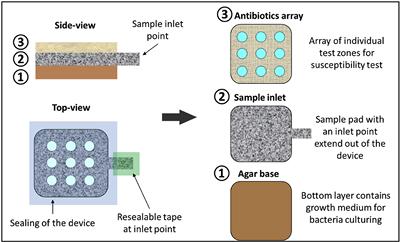Low-cost reliable point-of-care diagnostic for early screening of infections

NAMRIP member Dr Collin Sones and his team have developed a unique point-of-care microfluidic device which tests for both bacterial infection and its susceptibility to antibiotics. This is crucial in treating patients quickly and supporting accurate antibiotic prescribing. Critically the test is low cost and can be carried out by an unskilled user, making it especially useful within developing countries lacking in basic infrastructure and trained personnel.
Dr Sones, Dr Ioannis Katis, Dr Peijun He and Anto John Kumar had the opportunity to present this work to politicians and policy makers, including the Chief Medical Officer, as part of the NAMRIP team attending a Parliamentary AMR Reception in London last month.
The team tested the device on E.coli which contributes to 50-70% of all urinary tract infections (UTI’s). Worldwide there are an estimated 250 million UTI’s reported every year. Current testing for E.coli involves a preliminary laboratory-based, bacterial-culture using agar plates or broths and takes 2-3 days. The cultured microorganisms then undergo antibiotic-susceptibility testing which takes another 24 hours to indicate resistance. This leads to broad-spectrum antibiotics being prescribed to cover this long lead time prior to the results being available. These treatments may be ineffective with the patients health worsening, and they exacerbate AMR. In comparison, the device developed by the team greatly reduces the time to diagnose the infection allowing the correct antibiotic to be prescribed.

Made using a laser-based technique, the test paper has three layers – a top layer containing four common antibiotics in confined rectangular areas, an absorbent paper in the middle and an agar gel-containing base layer, all sealed in a plastic casing. The liquid sample (e.g. urine) is added to a small paper tab, which is then covered with tape to prevent drying out or contamination. The sample then spreads across the middle paper layer, coming into contact with the four rectangles containing the test antibiotics (amoxicillin, ciprofloxacin, gentamicin and nitrofurantoin).

If bacteria are present the paper will turn blue and if the infection can be treated with one of the antibiotics there will be a clear patch around the corresponding rectangle. As well as giving doctors an early identification of bacterial infection, the test also directs which one of the four common antibiotics will work best – or if it is a strain untreatable with any of them.
This research, funded by the Engineering and Physical Sciences Research Council, has been published in Biosensors and Bioelectronics where the paper can be freely downloaded. Peijun J.W. He, Ioannis N. Katis, Anto J.U. Kumar, Catherine A. Bryant, Charles W. Keevil, Bhaskar K. Somani, Nitin Mahobia, Robert W. Eason and Collin L. Sones (2020) “Laser-patterned paper-based sensors for rapid point-of-care detection and antibiotic-resistance testing of bacterial infections” Biosensors and Bioelectronics, 152, 112008
Following on from a visit to Uganda last year to attend the 2nd Global-NAMRIP conference, Dr Sones is planning to carry out a field trial in Uganda, where access to laboratory facilities can be limited.